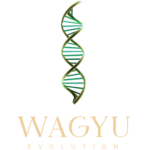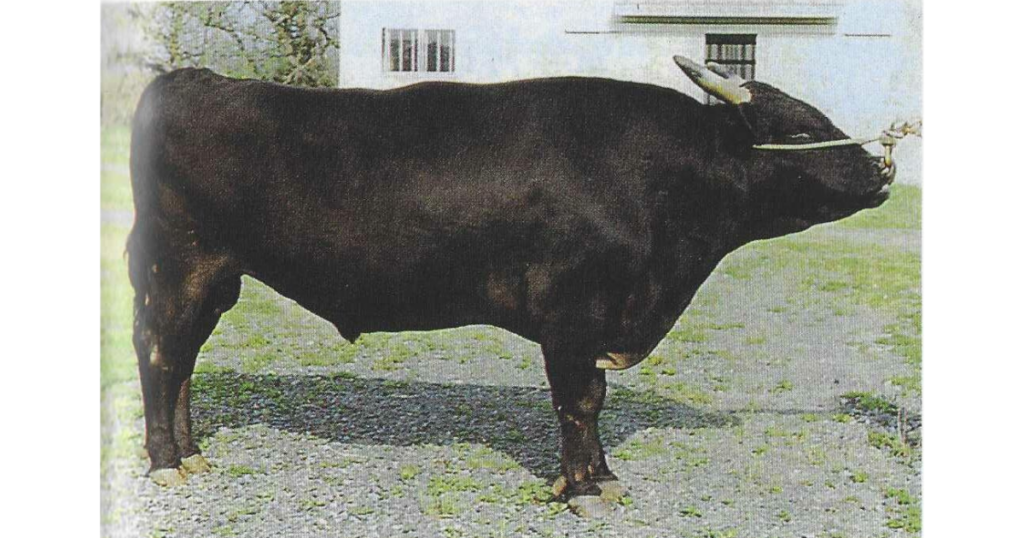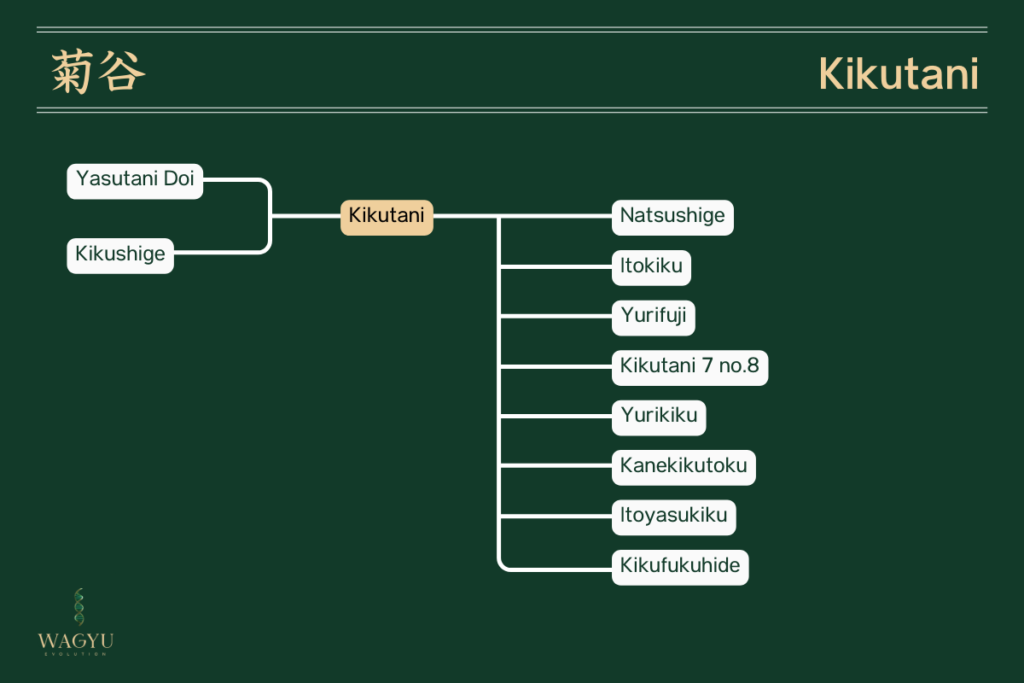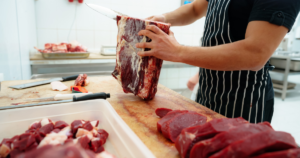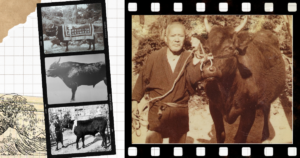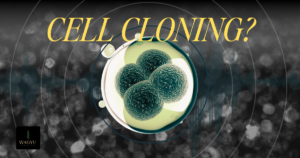Kikutani: The Pride of Iwate Prefecture
Table of Contents
* Note: This is not a direct translation of Kenichi Ono’s “Top 100 Famous Beef of Japan [Revised Edition]” but a summary that was written using it as a direct source.
Early Life
The most significant bull that elevated Iwate Prefecture’s Wagyu to a nationally recognized brand is likely “Kikutani.”
This bull was born on May 5, 1980 (Showa 55) at the home of Mr. Hideo Nishii in Muraoka Town, Hyogo Prefecture. The father was Yasutani Doi, a promising bull undergoing indirect testing at the time, and the maternal grandfather was Hidekiku of the Atsunami lineage, distantly related to Shigenami. Kikutani was later raised by Mr. Kanji Hirai and was put up for auction in 1981 (Showa 56). Due to its small size (weighing 430 kg), it was purchased by the Tamazato Agricultural Cooperative of Iwate Prefecture (now Esashi City Agricultural Cooperative) for 5.5 million yen, about half the price of Anfuku from the same year.
Starting in March 1982 (Showa 57), Kikutani was utilized throughout the entire Tanei region of Iwate Prefecture. Initially, Kikutani lived in obscurity overshadowed by two renowned bulls, Washito, who was approaching old age, and Teitoku, who gained popularity right after finishing his testing. However, in October 1985 (Showa 60), Kikutani’s indirect testing concluded with results surpassing those of Kotoku, with a DG (daily gain) of 0.81 kg, marbling (old standard) of +3.9, and a loin area of 55 cm. Around the same time, the fattening results at the Kanegasaki Agricultural Cooperative’s Fattening Center and Mr. Matsumoto’s farm in Mie Prefecture became evident, confirming Kikutani’s exceptional ability.
From the first year of Heisei (1989) onwards, Kikutani consistently placed among the top winners at the National Beef Carcass Competition held annually at the Tokyo Meat Market. In 1990 (Heisei 2), Ogata Farm in Maesawa Town won first place in the steer category, and Mr. Umeo Oikawa also won first place in the heifer category, both with Kikutani offspring. This streak of success continued, with Kikutani’s progeny consistently placing within the top three until 1995 (Heisei 7).
However, as he grew older, there have been slight variations in fattening performance. However, when Kikutani is the maternal grandfather, the fattening results are still excellent, indicating that the maternal line will likely be the primary focus moving forward. As of September 1996 (Heisei 8), Kikutani is still in service, with the number of straws (semen) produced exceeding 150,000.
Features
Strengths: Meat color, Marbling (Kozashi), Fine texture, Excellent marbling distribution in the round (thigh) area, Thickness of the loin muscle, Well-balanced body structure, Good facial features, Tight bones, Gentle and docile temperament
Weaknesses: Unsuitable for group feeding, Slightly insufficient weight gain, Fat necrosis, Weak constitution due to inbreeding in Hyogo Prefecture
Kikutani’s distinctive physical characteristics include long horns that spread out in a triangular shape and a wide forehead with a low-set neck. These traits are strongly inherited by its offspring, making it often easy to identify whether a cow is a descendant of Kikutani just by looking at it.
The offspring of Kikutani generally have a gentle disposition, but there are also many that are nervous or high-strung. When kept in groups of four or more, their feed intake tends to decrease, leading to variability in fattening performance. Recently, cattle raised in paddocks of six to eight heads with constant feeding have shown lower performance, indicating that traditional management with small groups and daily attention is most suitable. Additionally, breeding cows that are given high-calorie feed even slightly during their growth period tend to experience infertility or fat necrosis, so careful attention is necessary.
Pedigree Background
Kikutani’s father, Yasutani Doi, was a renowned bull representing Hyogo Prefecture, leaving behind notable sires such as Anfuku, Tanifuku Doi, Tanimoto Doi (Hyogo), Yasutani Fuku (Kagoshima), Tanishin (Nagasaki), Fukutomi* (Hokkaido), Ankin, Tanishige, and Tanihide (from breeding organizations).
The maternal grandfather, Hidekiku, was a distinguished bull of the Kumonami lineage, also known as the maternal grandfather of Hideyasu, the sire of Itoshige (see p.32), and has maintained strong popularity among some fattening farmers. The third-generation ancestor, Shioju, was also a famous bull known as the third-generation ancestor of the notable bull Amikin, from the breeding organization. Kikutani’s lineage has relatively little inbreeding over three generations, in contrast to bulls like Amikin and Chufuku from Kagoshima.
Similar to the Doi lineage and Kumonami lineage, Kikutani is a hybrid-type sire bull, characterized by a low occurrence of deformities and defective genes.
Main Successor Bull Candidates
There has been active breeding of successor bulls to Kikutani, especially in Iwate Prefecture, but so far, none have emerged as a definitive choice. However, Kenichi Ono listed some potential candidates for the future:
- Natsushige (Iwate Prefecture)
2nd generation ancestor Kenshō. Indirect testing results: DG 0.76 kg, BMS 2.4. Among Kikutani’s offspring, this bull has shown stable field performance, raising expectations for the future.
- Itokiku (Iwate Prefecture)
2nd generation ancestor Saikō. DG 0.82 kg, BMS 2.2. One of the early Kikutani offspring, worth paying attention to in the future.
Breeding Considerations & Recommendations
Recommmended Lines to Pair
Proven mating partners, such as Kotoku, Washito, Fukusho, and Shigenami, are all from lineages with low inbreeding coefficients, making bulls with distant bloodlines and high breeding value the ideal partners.
Improving Weight
To improve weight gain and reduce the tendency toward a weak constitution, mating with the Hirashige lineage or Itosakura lineage is considered highly effective for producing breeding females.
References
小野健一. 日本名牛百選〔改訂版〕(pp.71-76). 肉牛新報社.
